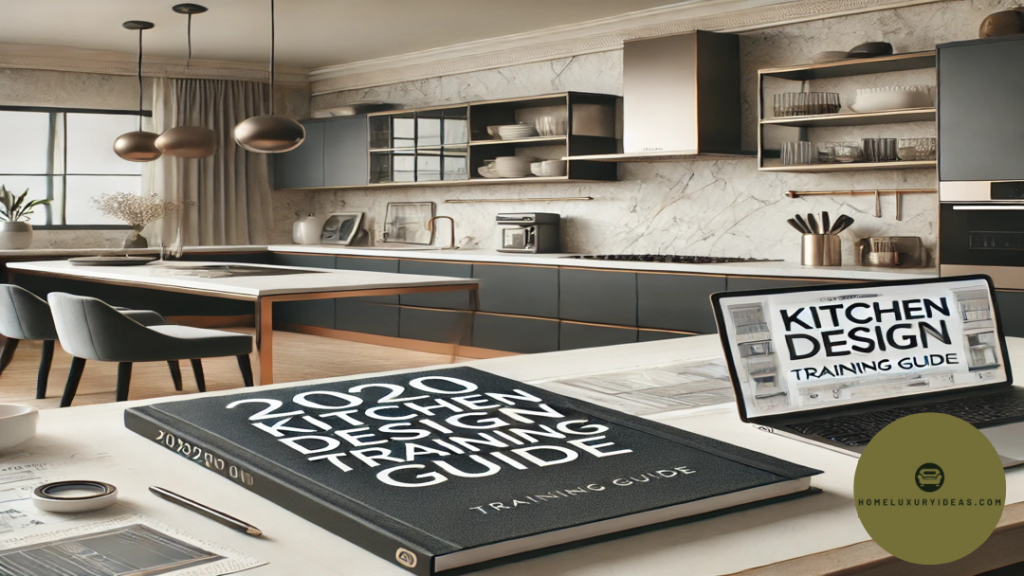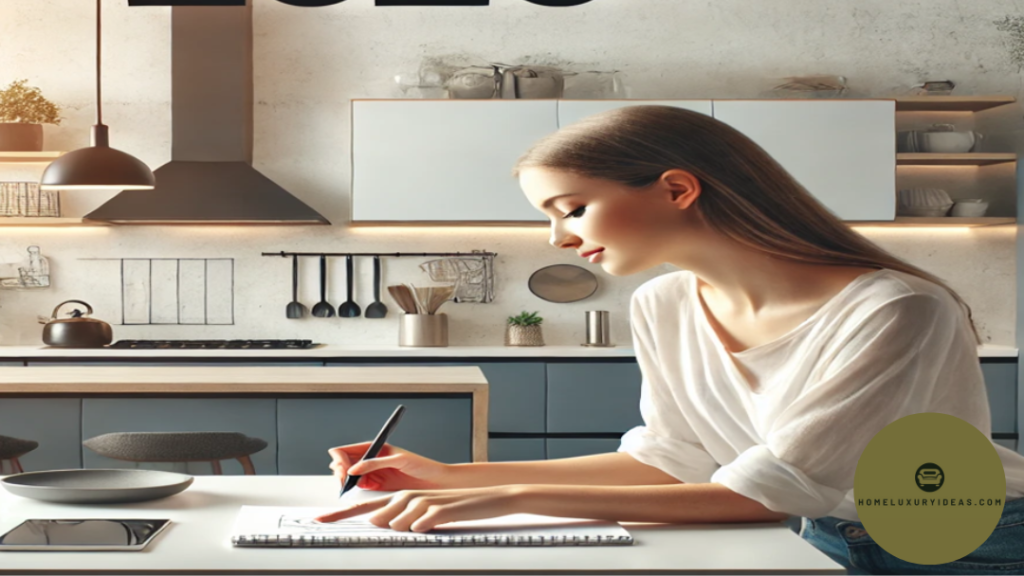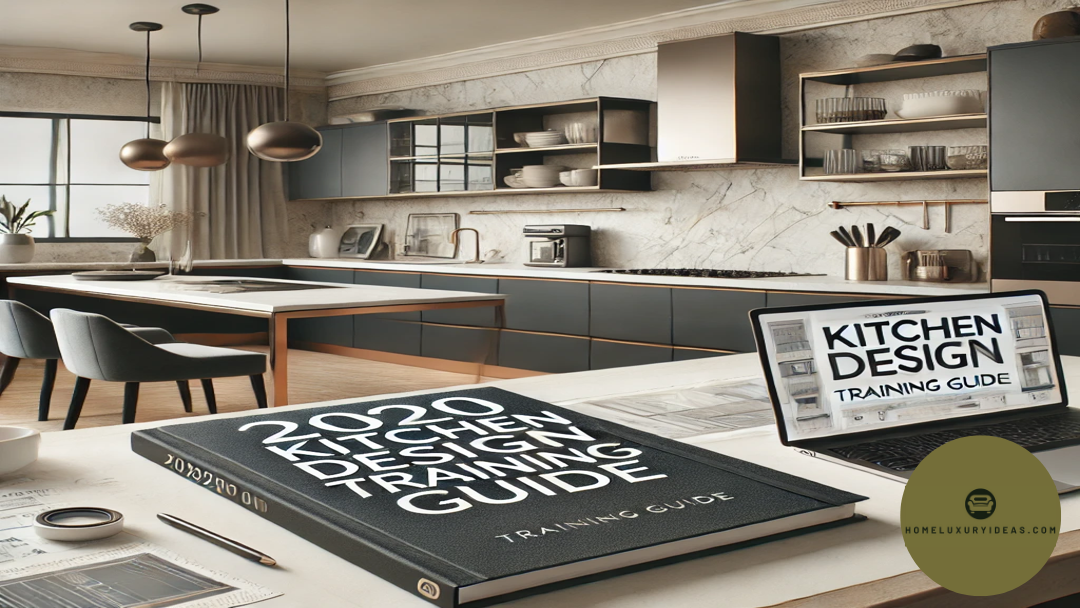They say the heart of the home is the kitchen. A kitchen is where food is cooked, family come together and culinary creativity blooms. With homeowners becoming more and more aware of the value of this area, there is a greater need for people who have 2020 Kitchen Design Training Guide.
As a kitchen designer, you need to stay relevant and you need to keep up with the technologies, materials and trends arising in 2020. This guide will explore the basics, trends, tools, and training techniques to elevate your kitchen design skills.

1. KNOWING THE FUNDAMENTALS OF KITCHEN DESIGN
The Importance of Layout
The kitchen layout is important for operation and work efficiency. The basics of kitchen layout is an essential part of training in 2020 kitchen design:
The Work Triangle: This is the relationship of your sink, stove and refrigerator with each other. A well-designed work triangle limits motion to what is necessary, leading to a fluid cooking experience.
Common Layouts:
L-Shaped: Flexible and functional workspaces, suitable for minimal spaces
These are great for large Kitchens U- Shaped: Base and overhead cabinets provide a lot of storage and space for counter-top preparation.
Island design: Adds to the preparation room and makes it a gathering place.
Storage Solutions
Well, effective storage is a godsend for a kitchen design. Here are some suggestions for including as part of your training:
Cabinets: Use shelves that pull out, and corner cabinets or dividers in drawers to maximize your storage without extinguishing the aesthetics of the area.
Open Shelving This is functional but more display-focused, which contributes to warming up the kitchen.

2. what is 2020 Kitchen Design Training Guide?
| Aspect | Details |
|---|
| Purpose | A comprehensive guide to mastering modern kitchen design techniques. |
| Focus | Provides expert insights, tips, and strategies for 2020 kitchen trends. |
| Audience | Designed for homeowners, designers, and professionals in kitchen design. |
| Key Benefits | Learn to combine style, functionality, and innovation in kitchen spaces. |
| Outcome | Helps create practical, stylish, and trend-forward kitchen environments. |

3. Lighting Considerations
One aspect of kitchen design that affects not only the functionality but also the ambiance or feel of a space, is lighting. In your training, focus on:
Lighting Schemes: A mixture of ambient light, task lighting, and accent light can increase the practical usability and decorative functionality of the kitchen.
Whether through windows or skylights, natural light creates the feeling of a warm and welcoming home.
4. The 2020 Kitchen Design Trends
With various distinct ranges of kitchen design, the designs keep changing from time to time and 2020 was a year that had some beautiful trends in the kitchen design. Every designer needs to keep up to these trends.
Emphasis on Sustainability
From there on, sustainable design was launched into the spotlight in 2020. With the increasing level of environmental awareness, more and more homeowners are exploring environmentally friendly materials and methods. Key elements include:
Recycled Materials : Architects frequently use recycled glass, metal, and wood chips to make unique designs in the kitchen because they save waste.
Energy-Conserving Appliances: Using Energy Star-rated appliances helps conserve energy and is a part of eco-friendly lifestyle.

5. Bold Color Schemes
Muted colors transitioned to daring, saturated hues. It was a time when homeowners started to welcome tones that showcase their personality and style. Popular choices include:
Bold Blues and Greens: These deep hues add richness to cabinetry and accent walls.
Earthy Warm Tones: Terracotta, mustard and olive tones create a warm atmosphere.
6. Smart Technology Integration
With all the technological advancement, smart kitchens have started popping up more and more. Smart features are another element of comfort and efficiency that designers need to think about with appliances and systems during the design phase. Features to explore include:
Smart refrigerators: These appliances can monitor what you have in stock, help make dinner ideas, and even compile shopping lists.
Automated Lighting Systems: Smart lighting can be automated to work according to time of day, which boosts usability as well as energy efficiency.
7. Methods of Training Future Design On Kitchens
A good kitchen design only comes with requisite training and aspiring designers should go through the entire skilling process. Here are a few approaches to try:
Online Learning Platforms
Many online platforms offer courses when it comes to kitchen design. Here are some great resources that can help you learn and develop your skills:
Coursera: Provides university-based courses that may include design principles, software usages, and industry trends.
LinkedIn Learning: Offers a variety of tutorials in design software, color theory and project management.
8. Practical Workshops
Design training must be hands-on and it can never be replaced. For aspiring designers, attending local workshops helps with:
Develop Technical, Soft Skills: Helps to learn about design techniques and communication skills. Gain Experience through Realistic Projects: Dealing with original kitchen designs develops practical abilities and solidifies portfolios.
Connect with other professionals: Networking can help you find mentors and focus your job search!
9. Design Software Proficiency
Navigating design software is one of the most important things for kitchen designers in this digital era. Some of the main programs include:
SketchUp : SketchUp is a 3D modeling tool designers use to create the imagery they need to visualize their ideas.
AutoCAD: this is a basic programmed necessary for developing accurate architectural plans and layouts.
10. Observational Learning
Books can only teach you so much — sometimes, it helps to hear from an established designer. Consider:
Job Shadowing: Spend time with experienced designers observing while they work on projects, seeing what makes up best practices.
Design reviews: Give and receive design feedback in critiques where you can show your work to others.
11. How to Construct a Portfolio that Gets Noticed
An extensive portfolio is an essential resource for every kitchen designer. It is the real demonstration of your skills, creativity and versatility. The following is a guide on creating an excellent portfolio:
Document Your Projects
Remember to document all phases that you go through while working on design projects. Include:
Customer Transformations: Nothing shows your expertise in creating beautiful spaces like before and after shots
Mood Boards: Assemble boards showcasing your vision for the design, with colors you intend to use, materials, and similar inspiration.
Showcase Variety
Express more styles in your portfolio to show off your variety. Consider:
Modern Styles: Feature clean lines, new materials, and modern design elements.
Conventional Designs: Convey your knowledge regarding the principles of longevity and classic styles.
Personal Projects
Make Sure you show what a good candidate looks like: include personal projects These projects highlight your initiative and creativity, whether its a redesign of your kitchen or a friends space.
12. Keeping Track of Your Industry Trends
Today kitchen design is actually an ever evolving world. Receiving updates about trends and innovations is an integral component of not just being competitive, but remaining competitive. Below, you can learn how to maintain that knowledge up to date.
13. Follow Industry Publications
Get subscriptions to industry magazines and websites covering kitchen design Notable publications include:
Dwell: A Lens on Modern Design and New Materials
Kitchen & Bath Business: Here you will find trends, products and best practices in kitchen and bath design.
14. Join Events and Conferences
Trade shows offer exposure to the latest products, technologies, and trends in kitchen design. Key events to consider:
KBIS (Kitchen & Bath Industry Show)– the leading show for trends, ideas and innovation in Kitchen and Bath
ICFF (International Contemporary Furniture Fair): Centered on contemporary design, providing an understanding of modern aesthetics and materials.
15. Connect with The Online Communities
Participating in online forums and communities focused on kitchen design can provide you with guidance. Designers can exchange concepts, find help when in need, and network on platforms like Houzz and Reddit.
Problems Faced After the Design of Kitchen and Ways to Solve it
As with any profession, there are difficulties in kitchen design. Identifying these challenges and having developed a strategy for overcoming them is the key to success.
16. Client Expectations
Most of our clients have ideas in mind for their kitchens. It’s a challenge to navigate these expectations AND stay true to your design. To address this:
Model 3: Communication Skills Use this model to give guidance on how to manage clients in your communication with them.
Flexibility: Be willing to be flexible with your designs, but also guide your clients towards practical solutions.
17. Budget Constraints
Design tendencies are defined and restricted due to the limitations of the budget. To manage this effectively:
Focus On The Essentials: Do not put too much emphasis on things that will require attention but actually make less difference in the whole design.
Explore Alternatives: Look into affordable options for materials and fixtures that provide the aesthetic you want without hurting your budget.
18. Staying Innovative
It is important to innovate in an industry with such competition. To foster creativity:
Keep Learning: Stay abreast of new trends, new materials and technologies to ensure your designs never feel stale.
Join Collaborative Projects with Others: Working with other designers or professionals can inspire brand-new thoughts and viewpoints.
19. Frequently Asked Questions (FAQ)
What Is The Training For Kitchen Design?
To design kitchens you training involves learning the principles, techniques and tools necessary to create functional and aesthetically pleasing kitchen spaces. It trains you on everything from how to plan your layout and maximize storage solutions, to color theory and software use.
How does knowing the trends matter when it comes to kitchen design?
By studying emerging trends, designers can create kitchens that reflect modern needs and preferences. Designs can be affected by trends —in the materials we use, in our color palettes and how technology features in a space— helping designers provide relevant and appetizing designs to their customers.
What Software to learn for kitchen design?
Some common kitchen design software available are SketchUp for creative 3D modeling, AutoCAD for detailed architectural drawings and 2020 Design which is specific to kitchen and bath design. Knowledge of these tools can help you to a great extent in designing.
How to create an awesome portfolio as a kitchen designer?
An essential tip is to create a robust portfolio where you blog about every project that you will work on with pre-post images, design boards, and writing describing your design process. Having a diverse set of styles and projects can further showcase your skills in variety and creativity.
How to get kitchen design clientele?
Networking at industry events and on the web, including social media, will help get you clients. Also, creating a professional website and relying on referral marketing by satisfied customers is an excellent way to get potential clients interested.
Are all certifications for kitchen designers?
A: Yes, there are certifications such as those offered by the National Kitchen & Bath Association (NKBA). A certification is valuable as it allows you to prove your knowledge and skills to others, which ultimately adds more credibility and faith in potential clients.
How do I know about the trends and innovations of the industry?
Staying up to date with industry publications, trade shows and online design communities are smart ways to do this. Another way of staying up to date would be to follow industry influencers on social media outlets.
20. Conclusion
The 2020 Kitchen-Design Training Guide will be your go-to guide for the kitchen design profession. Bringing you expert insights, practical tips, and innovative ideas, this guide will help you design a kitchen that blends style with function and contemporary appeal seamlessly. A holistic resource for anyone designing a kitchen, either for personal use or professional projects. So what are you waiting for, set out on your journey now so that you can be the proud owner of a kitchen in art and efficiency!
<script type="application/ld+json">
{
"@context": "https://schema.org",
"@type": "BlogPosting",
"mainEntityOfPage": {
"@type": "WebPage",
"@id": "https://homeluxuryideas.com/incredible-2020-kitchen-design-training-guide/"
},
"headline": "Incredible 2020 Kitchen Design Training Guide: Unlock Expert Insights",
"description": "Incredible 2020 Kitchen Design Training Guide: Unlock Expert Insights",
"image": "https://homeluxuryideas.com/wp-content/uploads/2024/11/2020-Kitchen-Design-Training-Guide-1024x576.png",
"author": {
"@type": "",
"name": ""
},
"publisher": {
"@type": "Organization",
"name": "",
"logo": {
"@type": "ImageObject",
"url": ""
}
},
"datePublished": ""
}
</script>
